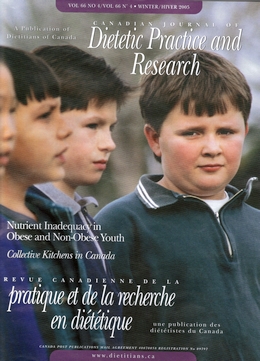Volume 67 • Number 4 • December 2006
Chair’s Message
Editor’s Message
Letters to the Editor
Research
Purpose: Demonstrating the effectiveness of nutrition counselling is imperative, not only to promote successful patient outcomes but also to secure funding. This study therefore assessed the value and effectiveness of nutrition counselling. Methods: To measure clients’ perceptions of the value of inpatient counselling, the Clients’ Perceptions about Nutrition Counselling (CPNC) instrument was administered to 164 clients one week after hospital discharge. To determine if inpatient nutrition counselling is effective in promoting changes in eating behaviours, the same clients were asked to complete the Health Habits and History Questionnaire (HHHQ) before counselling and then at three and six months following discharge. Results: The majority of respondents who completed the CPNC indicated that the information provided by the dietitian was useful, that the dietitian was knowledgeable, and that they knew what to eat after speaking with the dietitian and had changed their diet according to the recommendations. From the HHHQ, respondents counselled for heart health diet modifications (n = 45) significantly lowered their intake of energy (p<0.002), fat, saturated fat, sodium, and cholesterol (all p<0.001) over time. Conclusions: These results suggest that inpatient nutrition counselling is perceived as valuable and results in positive dietary behaviours, the majority of which are sustained at six months.
Purpose: To determine what food and nutrition-related learning takes place in collective kitchens (CKs) in three Canadian cities. Methods: Semi-participant observation and in-depth interviews were conducted with CK participants and leaders. Major nutrition-related themes that emerged were categorized and integrated to form a picture of how food-related knowledge and behaviours were affected as a result of CK involvement. Results: In general, CKs were perceived as an important source of food-related knowledge and skills. Some behaviour changes that resulted from participation were an increased variety of foods in the diet, increased vegetable consumption, and decreased fat consumption. Conclusions: Collective kitchens can be important tools for nutrition education. However, the broader social conditions, such as poverty, that influence food-related behaviours should also be taken into account.
Perspectives in Practice
In 1995, Oshawa General Hospital (now Lakeridge Health Corporation, Oshawa site) developed an interdisciplinary feeding and swallowing clinic to serve children with feeding problems. After four years, a retrospective chart review of 104 subjects was completed to assess the performance of the clinic, which consists of a pediatrician, a speech-language pathologist (S-LP), an occupational therapist (OT), and a registered dietitian (RD). Goals were set at the initial and follow-up visits. These goals were individualized according to client needs and were related to improvements in growth and/or feeding abilities. During this period, 176 of 232, or 75.9% (70-81, 95% confidence interval), of the initial goals were attained by the first follow-up visit. Progress in the clinic, as measured by the number of goals achieved by the first follow-up visit, was further analyzed according to the patient age group/category (i.e., infant, toddler, and child) and by the health care professional (i.e., S-LP, OT, and RD) to ascertain and compare success rates in these groups and professionals. The overall success rates in the patient age groups (p=0.07) and among the different professionals (p=0.92) were not significantly different. In short, the interdisciplinary team approach proved successful in treating feeding problems in patients referred to the clinic.
Although enteral formularies emerged over 30 years ago, their effectiveness remains to be clearly demonstrated. Enteral formulary (EF) development has occurred over 17 years at the Toronto Rehabilitation Institute (Toronto Rehab), and a historical account is available in the literature. At Toronto Rehab, the creative process begins with a review of specific nutrition support requirements for each patient population, which is coupled with a clinical decision-making algorithm to promote standardized clinical nutrition practices and selection of products. The requirements are translated into detailed product specifications for a streamlined array of oral and tube-feeding formulae. Despite outsourced food service systems, the feasibility of simple in-house production should be considered to help curtail overall costs. The promotion of consistent practices requires nutrition support guidelines, including indications and contraindications for each EF product. Competitive bidding practices and policies that scrutinize non-formulary requests and encourage automatic substitution for non-formulary products promote formulary adherence and contain costs. Ongoing evaluation is intended to capture changes in patient populations and product availability to target opportunities for future EF revisions.
Report
Purpose: Much has been published on the nutritional and health benefits of fermented dairy products, especially those containing probiotic microorganisms. However, consumers may not be familiar with the term “fermented dairy products,” and therefore may not take full advantage of them. University students’ knowledge and consumption patterns of fermented dairy products were assessed. Methods: University students (n=223) completed a survey consisting of a section on demographics and another on knowledge and consumption patterns. Results: The majority of respondents (62%) were not familiar with the term “fermented dairy products.” Most respondents consumed yogourt a few times a week (40%) or a few times a month (30%). Almost all respondents (92%) were unable to identify the difference between regular and probiotic yogourt. Most respondents (93%) had not heard of acidophilus milk, but the majority (65%) would be willing to try it. Most respondents were unsure whether sour cream (65%), yogourt beverages (74%), and cheddar cheese (61%) were fermented dairy products. Sixty percent of respondents never consumed yogourt drinks. Conclusions: Education is needed about fermented dairy products, especially probiotics, and their nutritional and health benefits. Such education may increase their acceptability and consumption.
Objectif: Les interventions à l’école axées sur l'acquisition de connaissances représentent des actions à envisager pour améliorer l'alimentation des jeunes Canadiens. À partir d'une nouvelle trousse éducative visant les élèves de 1re et de 2e année du primaire, ce rapport présente quelques attitudes et comportements d'enseignants ayant reçu et utilisé ce matériel éducatif. Méthodes: Au total, 504 écoles primaires du Québec ont été sollicitées à l'aide d'un questionnaire auto-administré. Un total de 214 enseignants (42,5 %) ont répondu, parmi lesquels 149 ont reçu la trousse et, de ce nombre, 63 l'ont utilisée. Résultats: La majorité des répondants est d'avis que l’école devrait allouer plus de temps à l’éducation en nutrition. Les thèmes les plus appréciés des utilisateurs de la trousse et de nouvelles thématiques ont été précisés. Les obstacles à l'utilisation en classe du matériel sont principalement liés au manque de temps. Conclusions: Les résultats témoignent de l'intérêt certain des enseignants à l’égard de la transmission de connaissances en nutrition à l’école et de la nécessité de prendre en compte les contraintes et les besoins des milieux pour que ces efforts d’éducation portent fruit.
Public Policy Statements
Nutrition therapy is an integral part of the management of gestational diabetes mellitus (GDM). Four leading nutrition and diabetes organizations, the Canadian Diabetes Association (CDA), Dietitians of Canada (DC), Diabète Québec (DQ), and the Ordre professionnel des diététistes du Québec (OPDQ), formed a partnership to develop evidence-based nutrition practice guidelines for the management of GDM. It was generally agreed that nutrition requirements during pregnancy are similar for women with or without diabetes. However, evidence supporting current nutrition therapy practice specific to these clients remains limited. Nutrition recommendations for the management of GDM provided here are built on the available evidence and the principles, practices and treatment goals of the Canadian Diabetes Association 2003 Clinical Practice Guidelines for the Prevention and Management of Diabetes in Canada. They identify areas where additional research is needed to support optimal nutrition therapy.










